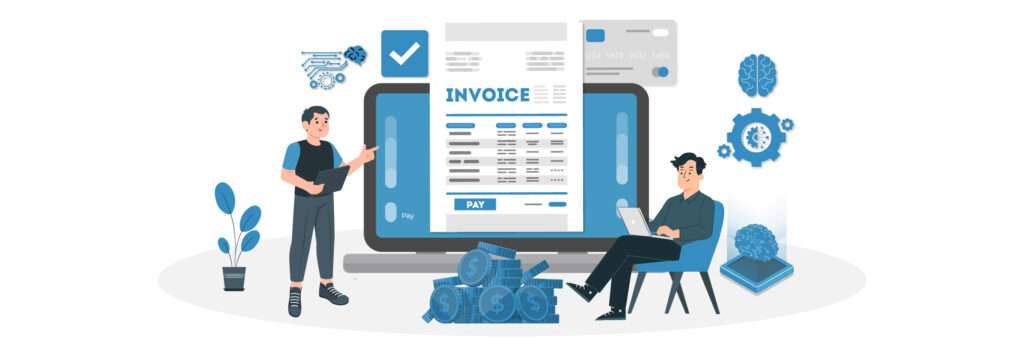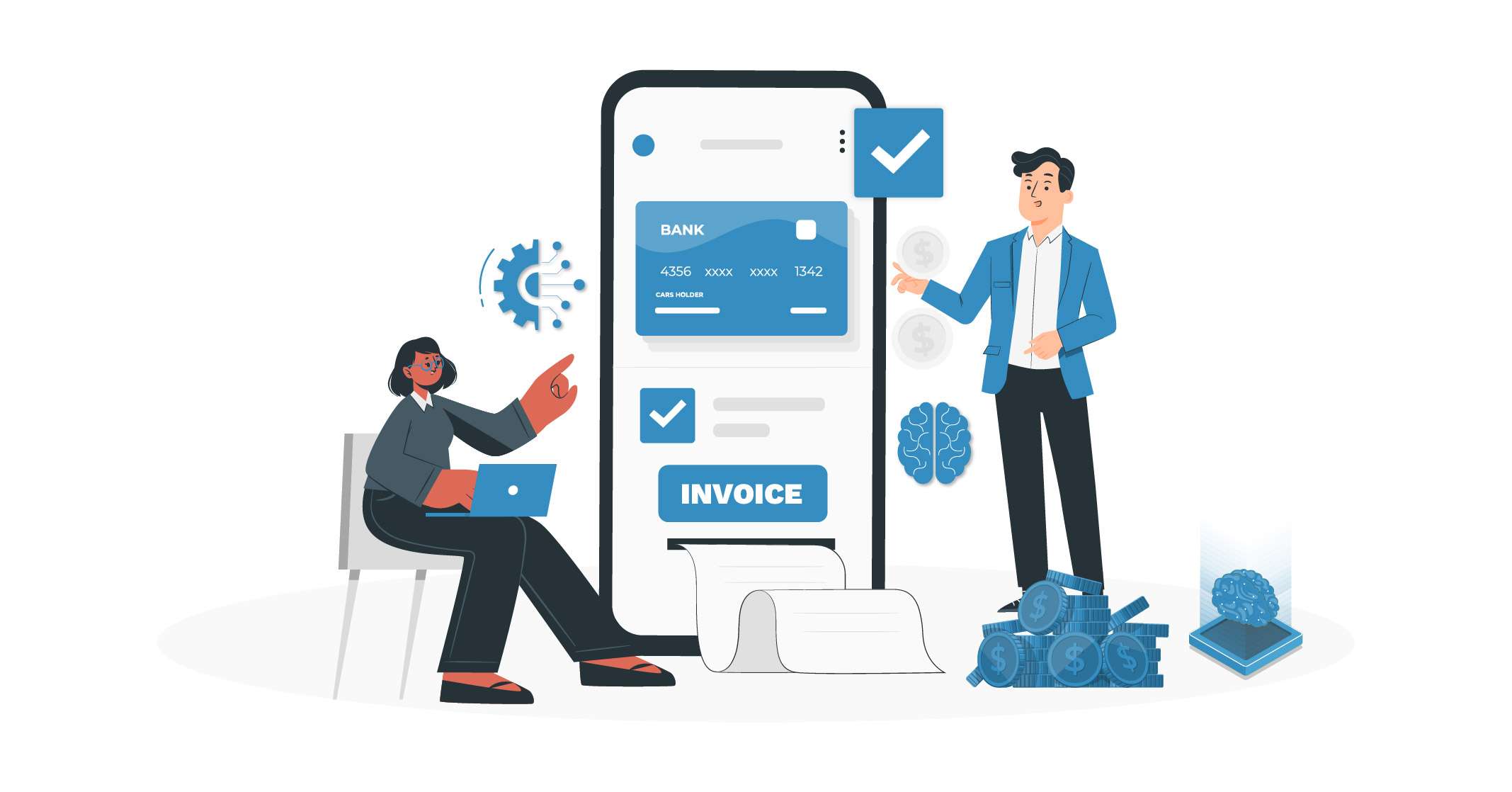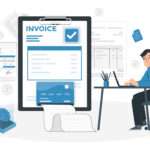Did you know the potential of AI contribution is slated to reach $15.7 trillion by 2030? Business automation owes its fair share of gratitude to AI. However, when it comes to invoicing; multiple companies still rely on traditional methods. While some are wary of AI invoice processing others are yet to realize its true potential.
Fortunately, not only can you leverage the benefits of automated invoice processing automation with AI, but you can also focus your time on better business pursuits.
From extracting data to identifying invoice mistakes, AI-based invoice processing is making AP (Accounts Payable) automation a reality rather than a distant dream.
While it will make your operations seamless, how does it work, why traditional methods are not reliable, and what are the long-term benefits of AI invoice processing? Well, we have detailed it all in this blog.
Let’s read more to understand better.
What is AI Invoice Processing?

AI invoice processing is imperative to transform your AP from being error-prone to automated and super-efficient. Traditional invoice management as opposed to automated invoice processing involves multiple steps and approvals.
At the same time, AI invoice processing automates the entire process. It utilizes Machine Learning (ML), Optical Character Recognition (OCR), and automated workflows to extract data, flag errors, and process correct payments.
When your systems can process data from multiple invoice formats and validate data, you can look forward to improving business processes. Furthermore, AI is constantly learning and improving, which is a win for sure.
Disadvantages of Traditional AP Methods

Now that you have some idea of AI invoice processing, let’s understand why there is an emerging need for AP automation.
1. Time Wasted in Manual Data Entry
Taking out data manually is not only labor intensive but takes away a lot of your precious time. While paper-based invoices are painstaking to process, digital invoices still require someone to check the data and extract the required information.
Also, the chances are higher that your ERP is not integrated with your accounting system and your staff needs to manually enter the data. This will double their effort and leave no room for them to focus on strategic tasks.
2. Increased Errors
Manual data entry is bound to have errors. Even the meticulous person will make mistakes when they are supposed to be manually processing large volumes of data. These errors can also lead to discrepancies in payments which can weaken vendor relationships and disturb revenue management.
3. Delayed Payments
Payment delays may be due to multiple reasons. However, one thing is common, they disturb your cash flow to a large extent. The approver can be busy, the invoice might have been lost, or it might have been sent to the wrong person.
Also, there are chances that the invoice has errors. While the reason may be legit it can strain client and vendor relations. You might also need to pay late fees as per your supplier’s norms in some cases.
4. Lack of Transparency
Paper invoices can get lost and so can digital invoices. Not having a central repository is a recipe for failure. Moreover, it also makes it difficult to maintain an audit trail. Also, it becomes next to impossible to implement 2 and 3-way matching. Thus, leading to fraud and compliance issues. All due to a lack of management and transparency.
5. Difficulty in Handling Multiple Invoice Formats
Invoices can be shared in the form of scanned images, word documents, and PDFs. However, not all systems are equipped to handle it effectively. This can lead to processing delays and even loss of invoices. Thus, leading to further frustrations and losses.
6. Lack of Scalability
As your business grows in size, so will your transactions and invoices. And, manually processing all of them can become a tedious task. You will not only need to hire more staff and deal with errors, but you are also at the risk of losing the trust of your vendors. Thus, it’s essential to plan resources strategically to propel growth.
7. Poor Cash Flow Management
Ineffective invoice payments process means an invitation to poor cash flow. Without a clear view of payments- incoming and outgoing, you will always struggle to manage your finances effectively. Missed payments, overpayments, and late payments all can lead to financial hurdles and accountability challenges.
8. Lack of Interoperability
Not all systems have the ability to establish communication with each other. While you may have an excellent invoicing system, it is futile if it cannot be integrated with your ERP system. This will lead to data silos, create more work, and data will need to be entered into multiple systems. Thus, adding to work and responsibilities gets you no results.
How Does AI Invoice Processing Work?

AI and automation-based invoice processing can help you reduce turnaround times from 17 days to 4 days. However, what makes it possible? Well, let’s check it out.
- Invoice Capture
AI solutions first scan the physical and digital invoices. All you need to do is upload invoices and the solution will convert the data into a machine-oriented format.
- Data Extraction
Once the data is captured, AP automation leverages OCR technology to extract relevant information such as vendor details, invoice number, date, total amount, and line item details.
- Data Validation
Post data extraction, AI does 2 way or 3-way matching depending on the nature of invoice or in other words, if it’s a service based or a quantity based invoice.
- Manual Intervention and Correcting Errors
If an anomaly is detected the invoice is flagged for manual review. Manual modifications help AI improve accuracy and serve businesses better.
- Route for Approvals
Once data is validated and errors are rectified, the software will route invoices to the relevant person/team for approval. This will help in maintaining control and transparency in the process.
- Payment Processing
Once approved the invoices are forwarded for clearance based on invoice terms and business rules. This lets you avoid late fees and maintain good relationships with your vendors.
Benefits of AI Invoice Processing

Here is how you will be at an advantage with AI invoice processing:
1. Streamlined Data Capture
The combination of AI and OCR technology lets you automate your entire invoicing process. Once the invoices are scanned and the relevant data is captured it is fed into the system. This will also help you reduce the time wasted on data entries and put your team to better use.
2. Reduced Errors
When you automate data extraction via ML and OCR you can reduce payment errors to a large extent. Any discrepancies are quickly flagged for review and this will help you prevent mistakes from turning into blunders.
3. Seamless Approvals
Traditional approvals can be lengthy and time-consuming. However, AI invoicing all approval levels would be laid down clearly within the system, ensuring invoices reach the concerned authorities at the right time.
Any unapproved orders can be tracked with ease. Moreover, AI invoice processing will also help you flag discrepancies before routing for approval. Since payment processing functionalities are in-built the payments are cleared once all approvals are in place.
4. Smooth Internal Controls
Deploying AI invoice processing will help you create a centralized system making it easier to manage internal controls. This also lets you set 2 and 3-way matching workflows efficiently. AI can quickly identify patterns and data discrepancies. Moreover, it ensures that all invoices are secured and confidentiality is maintained with data. Thus, increasing accountability and smooth control over the entire process.
5. Adapts to Multiple Invoice Formats
AI can help you extract relevant data from PDFs, scanned images, and other digital formats using OCR technology. It can easily cater to multiple invoice layouts, trade regulations, and currencies. These will come in handy when you are dealing with complex purchase orders and international suppliers.
6. Simplified Scalability
AI systems can easily be configured to fulfill your requirements with zero human intervention. You can onboard new vendors, process higher volumes of invoices, and tackle complex transactions with ease. Also, it can easily adapt to your changing business needs and automate more tasks if needed. It doesn’t matter if you are dealing with single or multiple invoices, AI can help you scale to your benefit.
7. Transparency in Financial Health
If you are looking to handle AP in a clear and transparent manner, AI invoicing is the key. AI-based systems can help you predict cash flows and help you plan your funds with ease. Moreover, it will reduce the risks of missed payments and late feed. With potential overpayments flagged, you can look forward to saved costs and improved finances.
8. Smoother Integration
AI invoice processing will help you automate invoicing across multiple systems. It can easily integrate with your existing systems and enable seamless data transfer. This will also help you eliminate data silos and reduce workload. Last but not least, AI is active 24/7. This means you can process invoices even after office hours and ensure no payment is missed out.
Serina: Simplifying Automated Invoice Processing

AI invoice processing tools are boosting businesses across the globe. When AP teams have the time to focus on strategic tasks, then only can they help you plan your finances better. While you may feel that implementing AI will burn a hole in your pocket, it is a worthwhile investment in the long term.
We at Serina believe that the benefits of AP automation must be enjoyed by all businesses alike. Now that you know about AI invoice processing, it is time we tell you about Serina. Here is why it should be a part of your business.
- Get access to all invoice details in real-time
- Track pending payments with interactive dashboards
- Leverage AP automation to keep your vendors satisfied
- Drastic reduction in data validation efforts with automated data capture functionalities
Wait, there is more to it! You also get access to expense analytics BPM and API tools, smoother optimization, and top-notch risk management abilities. With all these facilities at your beck and call, you can dedicate your precious time to acquiring high-ticket clients and improving customer services.
FAQs
1. Can AI create invoices?
Yes, AI-based invoice creation can be done in multiple digital formats. It can easily adapt to a host of languages, currencies, and invoice layouts. Thus, ensuring efficient invoice creation.
2. How does AI help with invoice processing?
AI lets you digitize documents, extract data, add the right data, cross-check invoices, and detect frauds with ease. By putting these tasks on autopilot, you can optimize payment cycles and manage cash flow with ease.
3. How to automate invoice processing?
AI, ML, and OCR(Optical Character Recognition) can help businesses with automated invoice processing. Besides, they will also be able to leverage seamless integrations, and real-time analytics and ensure compliance.
4. Should companies integrate an automated invoice processing solution with ERP software?
Yes, to save time switching between applications companies must integrate systems to ensure a unified source of information and they can make an informed decision on choosing the right solution too.



